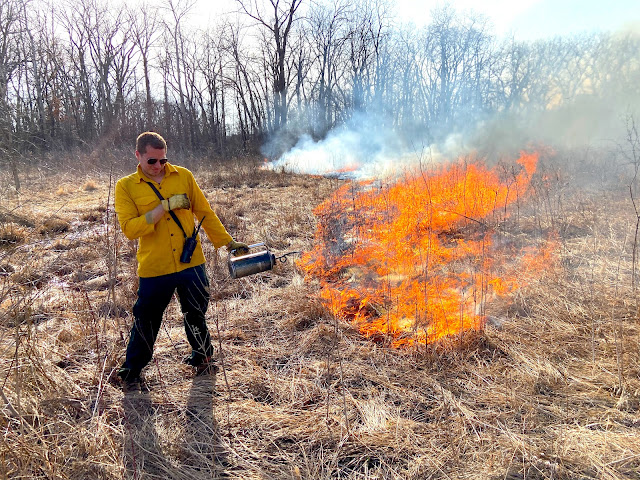It starts with a match - and some fuel - at 1:35 pm.
Initial cast of characters:Three stewards - trained in prescribed fire.
Christos Economou - left - holding drip torch.
Monica Gajdel - center - also holding second drip torch.
Heather Decker - right - holding flapper.
This is an easy burn, so Heather does a lot of training and rotation of jobs. We need more people who have this experience and ability. (Would you like to help with this important work? If so, come and volunteer and learn.) Now Eriko Kojima has the drip torch and is spreading the fire along a brushy edge. Mostly the flames just go out when they reach the end of fine fuels (especially grasses) at the edge of the brush. It would take a much drier, hotter, windier day for those thickets to explode with fire. But fire could creep out of the burn unit under oak trees, where the crispy oak leaves could carry a low fire, so the crew makes sure these backfires are all out before Eriko and her drip torch moves ahead.
We started at the north end, with a south and southwest wind. Now the fire along the brushy edge is extinguished, and the main backfire moves into the wind, toward the larger prairie.
4:35. And now I, the photographer, for your viewing pleasure and my own, stay put for a while. The next few photos show what happens, a few minutes apart.
4:37. Now the fire is mostly smoke. But the flames don't have far to go.
4:38 Within a minute, the main fire is out, most of the smoke has risen into the atmosphere, and the prairie ecosystem breathes a sigh of relief. This will be a good year for the heart of Shaw Prairie.
In those five minutes, the most important work of the day was done. The very-high-quality heart of this preserve is ready to face the 2022 growing season. But there's much left to do before this blessed day is complete.
At 4:45:29 PM, these edge flames start to consume a tangle of brush, mostly briars and dogwood shrubs.
The flames are very hot and could build fast, but a backfire has already crept through the downwind fuel, so by 4:45:36 - seven seconds later according to the camera - it's about over.
4:46. Just smoke left.
At 5:00, three and a half hours after we started, the fire was essentially out and all but a few wisps of smoke cleared. Little flames from brush stumps, here and there, burn down and out. The crew extinguishes any that look like they'd make passers-by uncomfortable.
Today was an inspiring day for the heart of Shaw Prairie. It had not burned in many years. In the photo above, the area to the right mostly did not burn because over the years it had grown so dense with brush that no fuel of dried grasses and flowers remained. We have sowed locally gathered seed to restore those areas. This fine prairie will produce vastly more seed this year, as that's what prairies do in response to fire. More needy areas of this fine preserve will benefit from all that seed. We stewards feel psyched about this whole next growing season. Yes!
For more detail on why we burn and how we control fire, click here. (Once again I'm plugging that new burn post. Many readers of this blog know it already. But most people don't. Feel free to send it to people you think could use the info.)
Acknowledgements
Thanks to Ryan London (Vice President of Conservation) and the whole team from Lake Forest Open Lands for fine leadership in this new collaboration with Friends of Illinois Nature Preserves.
This burn brought to you by:
Heather Decker - senior restoration ecologist
Christos Economou - steward
Monica Gajdel - steward
Eriko Kojima - steward
Kevin Kerrigan - restoration ecologist
Molly Marz - restoration technician
Interested in Burning and Stewardship?
We volunteer stewards always welcome new colleagues. Find out more details on Shaw, burns, and what you might help with at:
For the Shaw volunteer schedule, check out: https://friendsofillinoisnaturepreserves.org/events/
















No comments:
Post a Comment